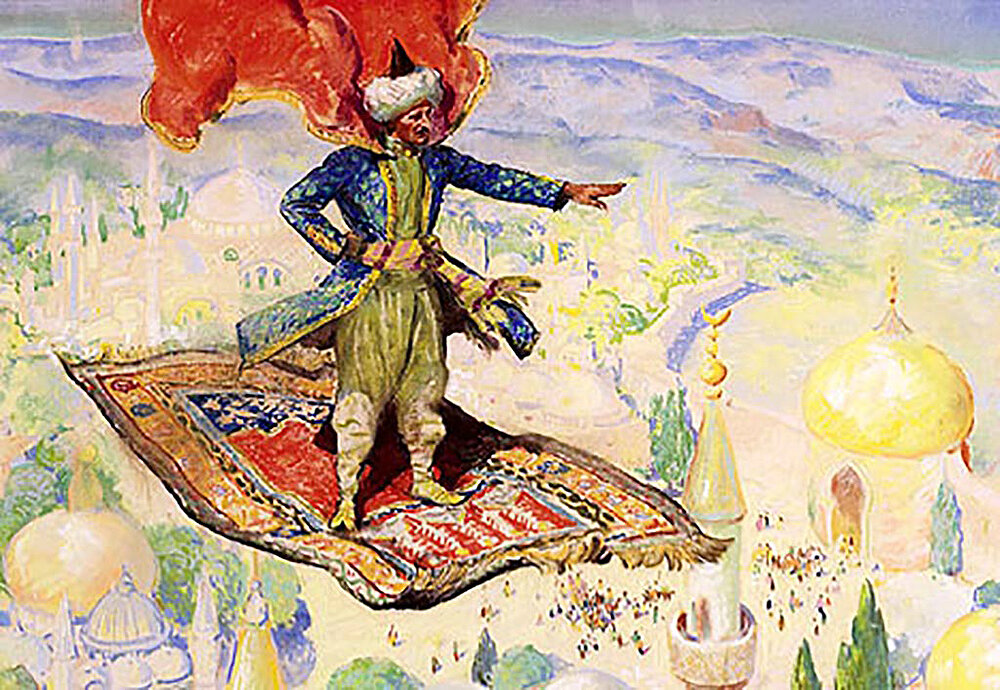Flying Carpets and the Power of Flight
1880 painting by Viktor Vasnetsov, titled The Flying Carpet and showing Ivan Tsarevich on his flying carpet, high above the ground.
Flying carpets are the stuff of folk tales and fantasy. They are magical objects with the power of flight, and anyone who owns one has considerable power over those who don’t. They can quickly transport their owners across the land at great speeds, and they allow their owners to achieve verticality. Nearly every drawing or painting of a flying carpet shows one or multiple people flying high above the landscape, among the birds and clouds. This height symbolizes power over the landscape and the people down below. It represents freedom from gravity, and the ability to travel great distances quickly.
The history of the flying carpet can be traced back to ancient times, and there are three main sources for the flying carpet concept. Each is a folk tale from a different culture, and each has a unique take on the floating tapestry.
Illustration by Arthur B. Houghton showing King Solomon on his flying carpet, being shielded from the sun by a flock of birds.
The first, and arguably most well-known is from the Hebrew myth of King Solomon. As the story goes, when God appointed Solomon king over all the land, he gifted him a carpet that could fly. It was massive, with some sources claiming it was sixty miles square, and others claiming it could transport 40,000 men. It was also super fast, and could make the trip from Media (in north-western Iran) to Damascus in about half a day. Solomon could control the carpet by giving it a destination, and the wind would carry it there. This worked well for Solomon until his pride grew too large and the wind shook the carpet until all 40,000 men fell to their deaths. This was essentially God telling Solomon to check his pride.
Painting from an edition of the Arabian Nights, showing Prince Hussain flying high above the city with his flying carpet. Original source unknown.
The second source is from the Arabian Nights, in the tale of Prince Ahmed and the Fairy Pari-Banu. In the early part of the story, the Sultan of the Indies has three sons, Hussain, Ali and Ahmed, who all wish to wed his niece, Nur al-Nihar. The King creates a contest to see who will win out, and sends each son off to find the most wonderous and marvelous object he can find. The oldest son, Hussain, finds a flying carpet at a bazaar, and the shopkeeper describes it thus: Whoever sitteth on this carpet and willeth in thought be taken up and set down upon another site will, in the twinkling of an eye, be borne thither, be that place nearhand or distant many a day’s journey and difficult to reach. The other two brothers each find a different item and return them to the king, who can’t decide which is the best. This is the last we hear about the carpet, as the story goes on to follow the youngest brother, Ahmed, through his subsequent adventures.
The third source is a Russian folk tale called The Firebird and the Grey Wolf. The main character of the story is Ivan Tsarevich, a common character in Russian folk tales. He was the subject of the painting shown above, by Viktor Vasnetsov. In one version of the story, Ivan sets out to capture a firebird and return it to his father, the king. He is assisted by the Baba Yaga, who gives him a magical flying carpet. After a few missteps, Ivan captures the firebird and returns it to the king. In Vasnetsov’s painting, Ivan can be seen riding the magic carpet with the caged firebird.
Viktor Vasnetsov’s 1926 painting, titled Flying Carpet, showing a man and woman on a flying carpet.
Each of these tales has a unique take on the flying carpet concept. In the case of King Solomon, his flying carpet was so big it was essentially a flying town. This is a marked contrast from the other examples, which are much closer to a normal carpet’s size. This allowed the king to take a major part of his kingdom with him when he traveled, which must’ve been quite a powerful statement to his enemies.
In the second tale, Prince Hussain’s flying carpet functioned as a teleportation device, which could travel across the world in the blink of an eye. This is a curious example because the travel is instant, which means the joy of flight and verticality is gone from the experience. This joy, combined with the human need for verticality, is a major factor in any flying carpet’s allure. This is evidenced by nearly every drawing and painting that shows a flying carpet, which show the subject soaring high above the ground.
In Ivan Tsarevich’s tale, we have less detail about the actual flying carpet, but Vasnetsov’s painting shows it as a symbol of Ivan’s triumph over the firebird. He returns having accomplished his quest, and his flight is a symbol of this triumph.
Taken as a group, these three tales provide us with an interesting perspective on the human need for verticality. The act of flight is a symbol for achieving verticality, and the power and freedom that accompanies flight is at work in each of these tales. The depictions of flying carpets throughout history almost always convey a sense of freedom and awe that unrestricted movement through the air provides. This is why these objects are so intriguing to us, even today.
Read more about other ideas for flying machines here.




